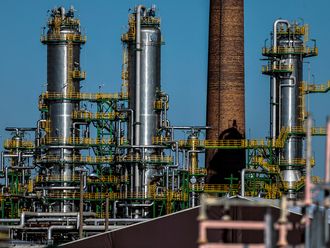Dubai
Oil extended gains as signs of declining US stockpiles pointed to healthy demand while investors weighed potential disruptions to supply because of global geopolitical tensions.
Futures in New York rose as much as 0.6 per cent after adding 2.5 per cent in the past three sessions. An industry report showed US inventories fell last week, with government data Wednesday forecast to show a fourth straight drop. Crude’s recent gains have been driven by fighting between the Iraqi government and Kurdish forces in the oil-rich Kirkuk region, which could stoke tensions beyond the country’s borders.
Iraq is just one of the oil market’s geopolitical risks, with uncertainty also growing over tensions between Iran and the US, Goldman Sachs Group Inc said Tuesday. The Arabian Gulf nation said it would support an extension of Opec output cuts to the end of 2018 and insisted its production plans won’t be disrupted by US President Donald Trump’s disavowal of the nuclear deal that’s boosted its exports.
“With Iraq and the Kurds, the effect of geopolitical risks on oil production is starting to be priced in again,” said Hans Van Cleef, senior energy economist at ABN Amro. “That’s one of the reasons we think that oil prices can go up further. The inventory data is coming up later today — that will be another driver. After the hurricane I think there is a good chance that there is a bullish report, and that is starting to be priced in.”
West Texas Intermediate crude for November delivery rose as much as 29 cents to $52.17 a barrel on the New York Mercantile Exchange and was trading at $52.07 as of 9:43am in London. Total volume traded was about 35 per cent below the 100-day average. Prices on Tuesday added 1 cent to close at $51.88, the highest since September 27.
Brent for December settlement rose as much as 50 cents, or 0.9 per cent, to $58.38 a barrel on the London-based ICE Futures Europe exchange. The global benchmark crude traded at a premium of $5.99 to WTI for December.
US inventories fell by 7.13 million barrels last week, the American Petroleum Institute was said to report. Data from the Energy Information Administration Wednesday is forecast to show a 3.25 million-barrel slide.
While Iraq’s government is clashing with Kurdish forces in the north of the Opec nation, raising the prospect of output disruptions in the region, both sides have an incentive to keep oil flowing due to low production costs and “high revenue” available per barrel, according to Goldman Sachs.
The Iraqi government offensive was triggered by a non-binding Kurdish referendum on independence that was approved overwhelmingly in September and made more politically charged by the regional government’s decision to include Kirkuk, even though it lies outside the semi-autonomous Kurdish region. The area is home to the country’s oldest oilfield.












